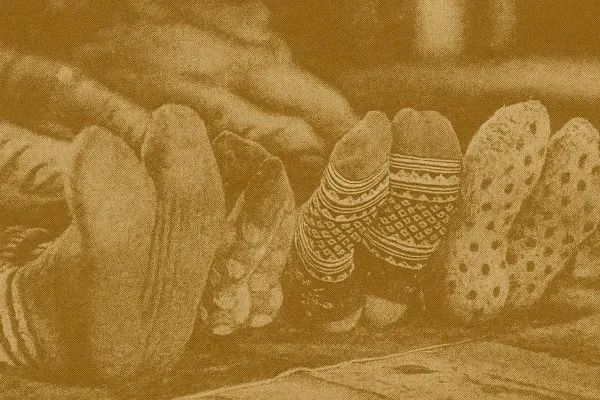Heads up: some of the links in this post are affiliate links. That means if you click and purchase, we may get a commission. It’s how we keep this site running without cluttering it with ads.
If your boots are the engine of winter, your socks are the fuel. The right pair keeps your feet warm, dry, and blister-free — and can even make an average pair of boots feel incredible. Yet socks are often overlooked when preparing for Canadian winters, where temperatures can plunge to -40°C, sidewalks turn to slush, and deep snow becomes part of daily life.
If you’re still choosing footwear, start with our guide to the best winter boots in Canada — then come back here to make sure your socks match the job.
In this complete guide, we’ll walk you through everything you need to know about choosing the best socks for winter boots, snow boots, and winter work boots, including what to look for in materials, weight, height, and fit — plus the best options for extreme cold and sweaty feet.
Why Socks Matter More Than You Think
Most people focus on the boots — waterproofing, insulation, traction — but socks are what make or break your winter comfort. The wrong socks can turn premium boots into cold, damp misery, while the right pair can transform even budget boots into cozy, dry havens.
Good winter socks do more than just keep your feet warm. They:
- Wick moisture away from your skin to prevent chilling.
- Trap insulating air close to your body.
- Provide cushioning against long hours on your feet.
- Reduce friction and blister risk during activity.
- Regulate temperature as conditions change.
In Canada’s diverse climates — from wet coastal winters in B.C. to deep freeze prairie mornings — choosing the right pair of socks is essential to surviving and enjoying the season.
How to Choose the Best Socks for Winter Boots
There’s no one-size-fits-all answer. The right socks for you depend on your climate, activity level, boots, and personal comfort preferences. Here’s what to look for:
1. Material: The Foundation of Warmth
The fabric of your socks determines how well they’ll perform. Here’s what you need to know:
- Merino Wool (Best All-Rounder):
The gold standard. Merino is warm even when wet, naturally odor-resistant, and incredibly soft — no itch. It regulates temperature beautifully and works well alone or layered with liners. - Merino + Synthetic Blends:
These add durability, elasticity, and faster drying times. They’re ideal for daily wear, hiking, and sweaty feet. - Synthetics (Polyester, Nylon, Polypropylene):
Lightweight, quick-drying, and tough — great as liners or for high-exertion activities. They’re less warm per gram than wool, though. - Alpaca:
Extremely warm and soft, often blended with synthetics for strength. Best for very cold, low-activity situations. - Silk Liners:
Ultralight and smooth, perfect as a friction-reducing base layer under heavier socks. - Cotton:
Avoid at all costs. Cotton holds moisture, gets cold quickly, and dramatically increases blister risk.
2. Weight / Thickness: Match to Conditions
The thickness of your socks should match the temperature and your activity level:
- Lightweight: Best for mild cold, commuting, or snug boots.
- Midweight (Most Versatile): Ideal for typical Canadian winters — balances warmth and moisture control.
- Heavyweight / Mountaineering: Designed for extreme cold, low activity, or roomy boots.
3. Cushion: Comfort and Warmth
Cushioning affects both comfort and insulation:
- Targeted Cushion (Heel/Toe): Reduces impact and hotspots — great for daily wear and hiking.
- Full Cushion: Maximum warmth and softness — ideal for snow boots and steel-toe work boots.
4. Height: Coverage and Protection
- Crew: A versatile option for most winter boots and hiking.
- Over-the-Calf (OTC): Best for snow boots and work boots — prevents rubbing and adds warmth.
- No-Show/Ankle: Skip these in winter. They leave gaps where cold air sneaks in.
5. Fit: The Unsung Hero
A good fit keeps circulation flowing and prevents friction. Look for socks that are:
- Snug in the midfoot and heel.
- Roomy enough in the toe box to allow movement.
- Not so tight that they restrict blood flow — compression reduces warmth.
Material Quick-Compare Table
| Material | Warmth | Moisture Control | Odor Resistance | Durability | Best Use |
|---|---|---|---|---|---|
| Merino wool | ★★★★☆ | ★★★★☆ | ★★★★★ | ★★★★☆ (blend) | All-round, city & trails |
| Merino/synthetic blend | ★★★★☆ | ★★★★★ | ★★★★☆ | ★★★★★ | Daily wear, hiking, sweaty feet |
| Synthetic only | ★★★☆☆ | ★★★★★ | ★★☆☆☆ | ★★★★★ | Liners, high exertion |
| Alpaca (blend) | ★★★★★ | ★★★☆☆ | ★★★★☆ | ★★★☆☆ | Extreme cold, low activity |
| Silk (liner) | ★★☆☆☆ | ★★★☆☆ | ★★★☆☆ | ★★☆☆☆ | Anti-blister base layer |
| Cotton | ★☆☆☆☆ | ★☆☆☆☆ | ★☆☆☆☆ | ★★★☆☆ | Avoid in winter |
Snow boots are only as good as the grip under them — pair your new socks with one of the best ice traction devices for winter boots to stay upright on icy sidewalks.
Best Socks for Winter Boots (By Scenario)
🏙 Everyday Commuting & City Wear
- Pick: Midweight merino wool crew socks with light or targeted cushioning.
- Why: Warm without bulk, odor-resistant, and comfortable for long days.
- What to look for: 50–70% merino, 25–45% nylon, 2–5% elastane.
❄️ Deep Snow & Low Activity (Best Socks for Snow Boots)
- Pick: Heavyweight, full-cushion merino or merino-alpaca blend, OTC height.
- Why: More loft = more warmth when standing or moving slowly.
- Pro tip: Make sure your boots have room for thicker socks.
🛠 Winter Work Boots & Steel Toe
- Pick: OTC, abrasion-resistant blends with reinforced toe/heel and full toe-cap cushion.
- Why: Reduces pressure points and stays up under heavy movement.
- Bonus: Moisture channels, arch support, and anti-odor treatment.
🥾 Winter Hiking Boots
- Pick: Midweight merino blend with targeted cushion and compression.
- Why: Keeps sweat under control on climbs while staying warm at rest.
🧊 Extreme Cold & Arctic Conditions
- Pick: Layering system — thin synthetic or silk liner + heavyweight merino outer.
- Why: Liner wicks sweat, outer traps heat.
- Pro tip: If your feet are still cold, loosen boot laces — tight boots restrict blood flow.
🏃♂️ Cold Weather & Sweaty Feet
- Pick: Merino-synthetic blend with ventilation panels, or liner + midweight merino.
- Why: Prevents "cold soak" after sweating.
Should You Wear Wool Socks in Winter Boots?
For most people, yes — merino wool is the sweet spot for warmth, softness, and odour control. Blends with nylon or elastane boost durability and drying speed, making them ideal for daily use in Canadian winters.
How Thick Should Socks Be for Winter Boots?
Match thickness to your boots and activity level:
- Snug urban boots: Light or midweight socks.
- Roomy snow boots: Heavyweight socks or a liner + midweight combo.
If you can’t wiggle your toes, your socks are too thick — and ironically, you’ll feel colder.
Should You Wear Two Pairs of Socks?
Sometimes. A liner + outer system is excellent for extreme cold or low activity. But avoid two thick pairs — that increases friction and restricts circulation. Always test at home before heading out.
Sock Height Guide
- Crew: Great for most boots and winter hikes.
- Over-the-Calf (OTC): Best for snow boots and work boots.
- Ankle or no-show: Avoid — they leave gaps where cold air enters.
Care & Lifespan Tips
- Wash: Cold or warm, inside-out, with mild detergent.
- Skip fabric softener: It clogs fibers and kills wicking performance.
- Dry: Air-dry or tumble dry low.
- Rotate: Own at least 3–5 pairs to let socks fully dry between wears.
- Repair: A quick darn can extend their life significantly.
Quick Picks by Need
- Best overall: Midweight merino-blend crew with targeted cushion (55–65% merino).
- Best wool socks: ≥70% merino with nylon reinforcement and lifetime warranty.
- Warmest socks: Heavyweight OTC merino or merino-alpaca + liner.
- Best work boot socks: OTC merino blend with reinforced toe/heel and full cushion.
- Best for snow boots: Heavyweight OTC, full cushion, roomy fit.
- Best for sweaty feet: Merino-synthetic blend with mesh panels or liner + midweight merino.
Popular brands include Darn Tough, Smartwool, Icebreaker, Wigwam, Fox River, and Farm to Feet — but always check the material mix and features, not just the logo.
Winter comfort isn’t just about your boots and socks — it’s about staying safe on every icy surface. Check out our guide to keeping your driveway ice-free to make sure your paths are as ready for winter as your feet.
FAQ: Winter Boot Socks in Canada
What socks should I wear with snow boots?
Heavyweight or midweight OTC merino wool socks are best. Go thicker if you’ll be standing still a lot, but make sure the boots aren’t too tight.
Are wool socks best for winter boots?
Yes. Merino wool is the most versatile choice — warm even when damp, odor-resistant, and soft. Blends improve durability and dry time.
Should I wear two pairs of socks?
Only in extreme cold or low activity. Pair a thin liner with a heavier outer sock. Avoid wearing two thick pairs.
What are the best socks for sweaty feet in cold weather?
Merino-synthetic blends or a synthetic liner under a merino outer work best, as they wick moisture and prevent that cold, damp feeling.
How many pairs do I need for a Canadian winter?
Own at least 3–5 pairs to rotate through the week. This lets each pair dry fully and last longer.
Final Word: Never Underestimate the Power of a Good Sock
Choosing the right winter socks might seem like a small detail, but it makes a huge difference in your comfort, warmth, and safety during a Canadian winter. Whether you’re commuting in the city, shoveling snow in a blizzard, or trekking across frozen trails, investing in the right socks ensures your boots work at their best — and your feet stay happy, no matter what winter throws at you.








